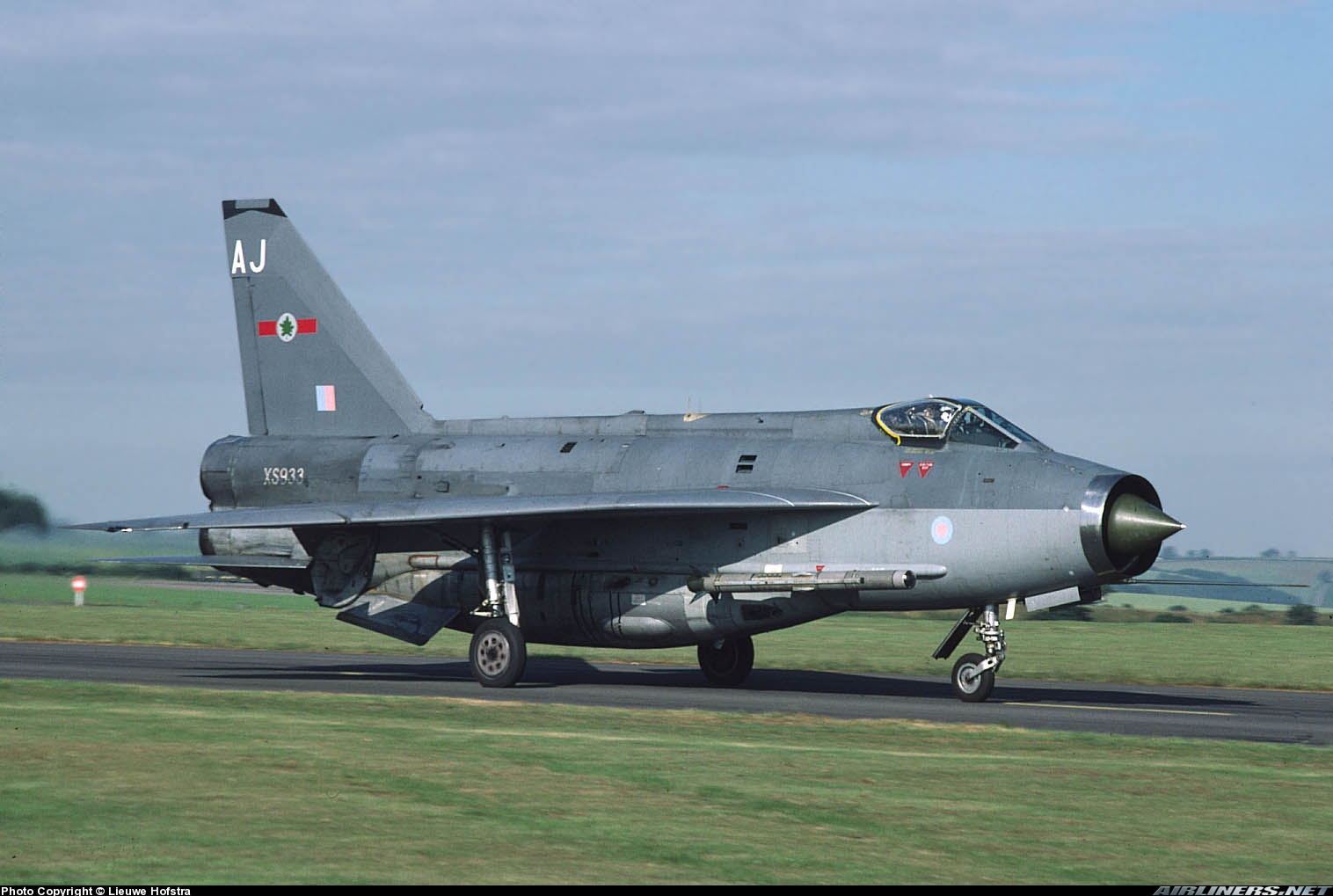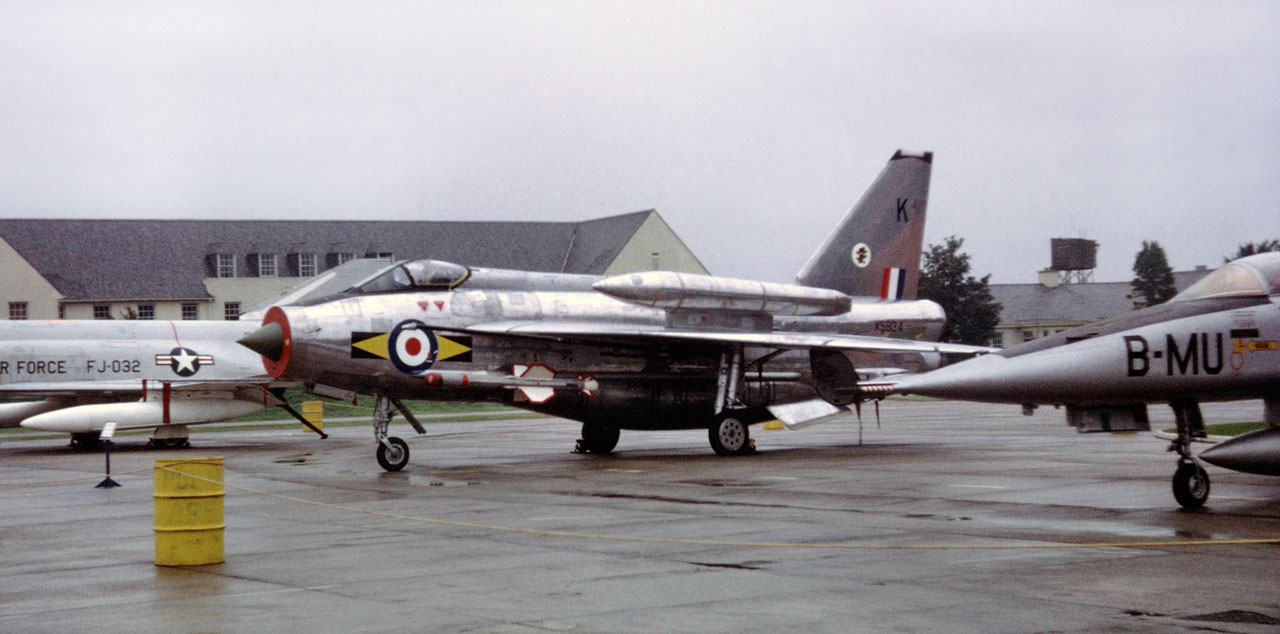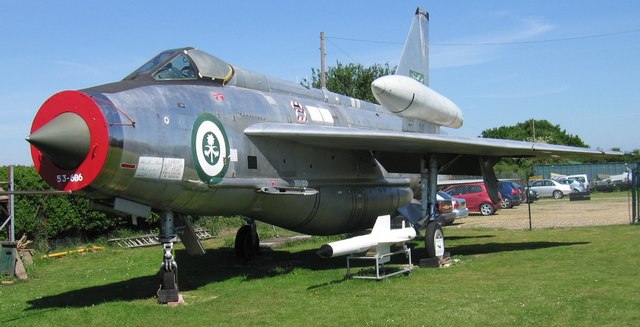TS
letnan.bejo
(mirip mig-21) English Electric / BAC Lightning Interceptor (1960)
The English Electric Lightning remains the only Mach 2-capable jet-powered fighter to emerge solely from Britain.

The English Electric Lightning was Britain’s primary defender of air space during the Cold War from 1960 on. The Lightning saw 28 years of active service in the RAF.
The Lightning ‘started’ life as the P1 – a prototype designed by W. Petter. The P1’s shape near enough mirrored the now familiar Lightning’s shape and was the first British designed aircraft to fly at Mach 2 – this it achieved on November 25th 1958 in a test flight.

The English Electric Lightning was known as a point interceptor. For the 28 years that the Lightning was in service, it was best known as the aircraft that would intercept aircraft from the USSR as they approached the UK’s air space. Lightning’s based at RAF Leuchars in Scotland were part of the Northern Quick Reaction Alert (QRA) unit and more often than not it would be a Soviet Tupolev Tu-95 Bear that needed to be escorted away from the UK’s air space.

The Lightning was designed to get to its target quickly – hence its name – but it had a remarkably short endurance once in the air – 35 minutes was not unusual during a supersonic sortie. The shape of the Lightning meant that space for fuel was at a premium and while the Lightning carried as much fuel as its design allowed, it was not sufficient to keep it in the air for long when it flew at speed.
Early versions were also handicapped by being equipped with radar that was designed in the 1950’s and only had a range of 30 miles. Later versions were fitted with the more modern Ferranti radar. A 1957 Defence White Paper had made it clear that the Lightning was only meant to be a stopgap and that a long-term fighter interceptor was to be designed to replace it. Therefore when it first flew as a RAF aircraft in 1960, shortcomings were expected. However, its advantages outweighed its disadvantages.


The Lightning had a very good rate of climb as required by a point interceptor jet. Its initial rate of climb was 50,000 feet a minute but this steadied out so that the Lightning could reach 40,000 feet in just 2 minutes 30 seconds. An advert for the RAF at the time stated “Want to climb two Everest’s in three minutes?” Powered by Rolls-Royce Avon engines, the Lightning was supersonic and reached Mach-2 speeds. In 1985, a Lightning reached a speed of Mach 2.2. Pilots frequently commented about the ease with which the aircraft handled even at speed.
“Yes, short legs, but a great turning radius and excellent acceleration.” Major Bill Beardley, USAAF.
The F6 Lightning variant was considered by many to be the best. It was faster than the previous variants but carried more fuel thus giving it an even better range. The only negative from a pilot’s point of view was that the original F6’s were not equipped with cannon. However, later versions were – even if such an addition reduced its total fuel load.
English Electric / BAC Lightning F.Mk 6
Country of Origin: United Kingdom
Manufacturer: English Electric Company / British Aircraft Corporation - UK
Initial Year of Service: 1960
Production: 337
Crew: 1
Length: 55.25 ft (16.84 m)
Width: 34.84 ft (10.62 m)
Height: 19.59ft (5.97 m)
Weight (Empty): 28,036 lb (12,717 kg)
Weight (MTOW): 41,991 lb (19,047 kg)
Powerplant: 2 x Rolls-Royce Avon 301 engines generating 16,360lbs of thrust with afterburn.
Maximum Speed: 1,312 mph (2,112kmh; 1,140 kts)
Maximum Range: 802 miles (1,290km)
Service Ceiling: 55,020 ft (16,770 m; 10.4 miles)
Rate-of-Climb: 50,000 feet-per-minute (15,240 m/min)
Hardpoints: 4
Armament Suite:
STANDARD:
2 x 30mm ADEN cannons in nose
OPTIONAL:
2 x de Havilland Firestreak infrared air-to-air missiles OR 2 x Hawker Siddeley Red Top infrared air-to-air missiles
8 x Matra rocket pods (18 x SNEB 68mm rockets) OR 4 x Matra JL-100 rocket pods (19 x SNEB 68mm rockets)
Conventional Drop Bombs
Conventional Drop Tanks
"Overwing" Fuel Tanks
5 x Vinteen 360 70mm cameras
Up to 6,000lbs of external ordnance.
Variants:
SB.5 - Short Brothers smaller scale developmental airframe for testing various wing sweep and tailplane designs.
Operators:
Kuwait; Saudi Arabia; United Kingdom; South Africa (civilian); United States (civilian)
While RAF Lightning’s flew to intercept unknown targets, they never flew in a combat situation so how it would have handled in actual combat against modern jet fighters is not known. In 1963, Lightning’s took part in exercises with Spitfire Mark XIX’s in preparation for combat missions in Indonesia but the expected missions never took place.
http://www.historylearningsite.co.uk..._lightning.htm
++++++++++++++++++++++++++++++++++++++++++++++++++++++++++++
FIRESTREAK AIR-TO-AIR MISSILE
The de Havilland Firestreak was a British first-generation passive infrared homing air-to-air missile. It was developed by de Havilland (later Hawker Siddeley) in the early 1950s and was the first such weapon to enter active service with the RAF and Fleet Air Arm, equipping the English Electric Lightning, the de Havilland Sea Vixen and the Gloster Javelin. It was a rear aspect fire-and-forget pursuit weapon with a field of attack of 20 degrees either side of the target.
The missile was initially code named Blue Jay and was designed with cropped delta wings mounted just rear of the midpoint and small rectangular control surfaces in tandem towards the rear. The first airborne launch of Blue Jay took place in 1955 from a de Havilland Venom – the target drone, a Fairey Firefly, was destroyed. Blue Jay Mk 1 entered service in 1957 with the RAF who renamed the missile Firestreak; it was deployed by the RAF and the Royal Navy in August 1958.
For launch, the missile seeker was slaved to the launch aircraft’s radar (Ferranti AIRPASS in the Lightning and GEC AI.18 in the Sea Vixen) until lock was achieved and the weapon was launched. Once launched, the interceptor was then free to acquire another target.
The Firestreak remained in limited service until the final retirement of the Lightning in 1988.

============================================================
dikatakan yang pertama bisa supercruise(http://www.militaryfactory.com/aircr...ircraft_id=229) dan hampir"bertemu" dengan penjaga langit bumi selatan.
dan punya cara penyimpanan tangki cadangan yg aneh.
0
7.7K
5
Thread Digembok
Urutan
Terbaru
Terlama
Thread Digembok
Komunitas Pilihan